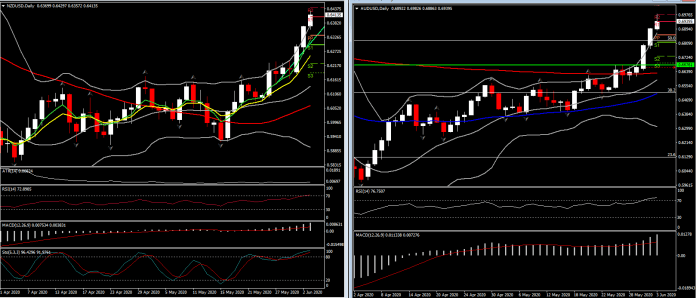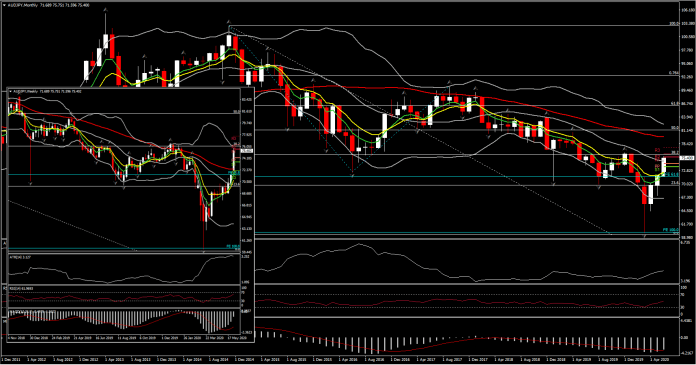Australia in recession. Australia GDP contracted -0.3% q/q in the first quarter of the year, as the economy was hit by bushfires and the first impact of the virus outbreak in China. The second quarter will of course be much worse as the pandemic spread and lockdowns came into effect. Officials already acknowledged that the economy is in recession for the first time in 29 years. The annual growth rate in Q1 was already the slowest since September 2009 – i.e. since the financial crisis. Meanwhile building approvals contracted -1.8% in April, much less than expected while March data were revised higher. Final services and composite PMI readings for May also brought slight upward revisions and there is some hope that the second quarter may not be as dismal as feared initially.
Yesterday the RBA left official interest rates unchanged at 0.25%, as widely expected. The bank highlighted a “severe downturn” in the global economy, but also said that “globally conditions in financial markets have continued to improve”, even if there is still fragility in some areas. Australia’s economy is going through the biggest economic contraction since the 1930s, but the RBA also said in its statement that “it is possible that the depth of the downturn will be less than earlier expected”, noting signs that hours worked stabilised in early May and a pick up in some form of consumer spending. The “outlook remains highly uncertain” and against that background it is likely that “fiscal and monetary support will be required for some time”. “The Board is committed to do what it can to support jobs, incomes and businesses and to make sure that Australia is well placed for the recovery.”
Aussie is the forex market outperformer for a second day in a row, presently about 320 pips off its open price on Monday against USD. In second spot, is NZDUSD with a 0.9% gains for the day, while AUDJPY and NZDJPY are showing a 0.40% gain. The outperformance of the high-beta commodity currencies juxtaposed to the underperformance of the safe-haven Yen and Dollar reflects risk-on positioning, underpinned on a cocktail of economic reopening across the world and expectations for more stimulus. Optimism has dented the Dollar broadly, as demand for the safe-haven currency wanes.
AUDJPY, widely considered a currency barometer of risk appetite in global markets, has reached its highest levels since mid January, as has AUDUSD. Other than the economic recession in Australia and RBA’s action, there are risks to the prevailing glass-half-full viewpoint, which could give rise to a correction in the commodity currencies. US-China tensions is one, especially if it spills over into trading relations. Also, with many assets having recouped to pre-pandemic levels, there may now be less upside potential with most economies across the world unlikely to fully recover until such time there is a vaccine or cure for the coronavirus.
Now for the Aussie, the recovery has subsequently taken a key step forward after moving further above the 50% Fib. retracement level on 3 years decline . The market could now look for a correction between the 0.6800-0.6900 area, coinciding with the 50% FIb. level. With 3 strong bullish weeks so far (the 3rd hasnt confirmed yet), the key December 2019 high at $0.7030 looks a realistic upside target to be retested over the coming weeks, while the 0.6850 looks to be a potential Support level for recovery if the asset pull back within the week.
Momentum confirms the strength of the breakout too, with daiyl RSI at 76 and at 3-year highs, whilst MACD lines are similarly bullish.
Disclaimer: Nothing in this communication contains, or should be considered as containing, an investment advice or an investment recommendation or a solicitation for the purpose of purchase or sale of any financial instrument.
Recommended Content
Editors’ Picks
AUD/USD pressures as Fed officials hold firm on rate policy

The Australian Dollar is on the defensive against the US Dollar, as Friday’s Asian session commences. On Thursday, the antipodean clocked losses of 0.21% against its counterpart, driven by Fed officials emphasizing they’re in no rush to ease policy. The AUD/USD trades around 0.6419.
EUR/USD extends its downside below 1.0650 on hawkish Fed remarks

The EUR/USD extends its downside around 1.0640 after retreating from weekly peaks of 1.0690 on Friday during the early Asian session. The hawkish comments from Federal Reserve officials provide some support to the US Dollar.
Gold price edges higher on risk-off mood hawkish Fed signals

Gold prices advanced late in the North American session on Thursday, underpinned by heightened geopolitical risks involving Iran and Israel. Federal Reserve officials delivered hawkish messages, triggering a jump in US Treasury yields, which boosted the Greenback.
Runes likely to have massive support after BRC-20 and Ordinals frenzy

With all eyes peeled on the halving, Bitcoin is the center of attention in the market. The pioneer cryptocurrency has had three narratives this year already, starting with the spot BTC exchange-traded funds, the recent all-time high of $73,777, and now the halving.
Billowing clouds of apprehension

Thursday marked the fifth consecutive session of decline for US stocks as optimism regarding multiple interest rate cuts by the Federal Reserve waned. The downturn in sentiment can be attributed to robust economic data releases, prompting traders to adjust their expectations for multiple rate cuts this year.

